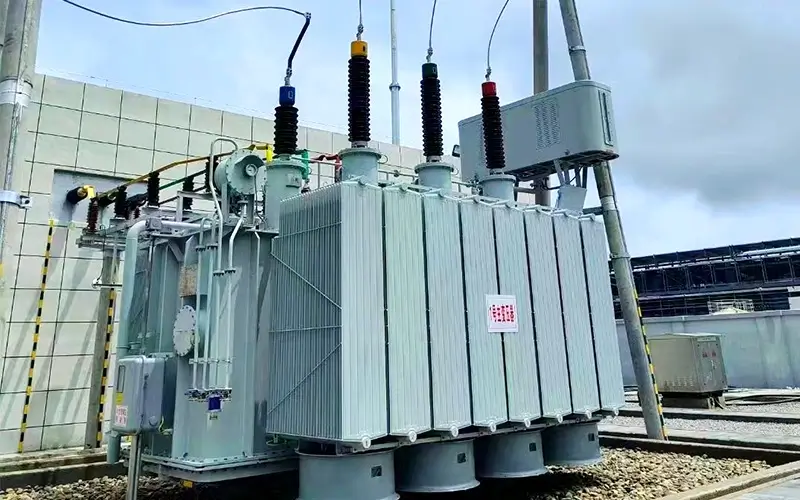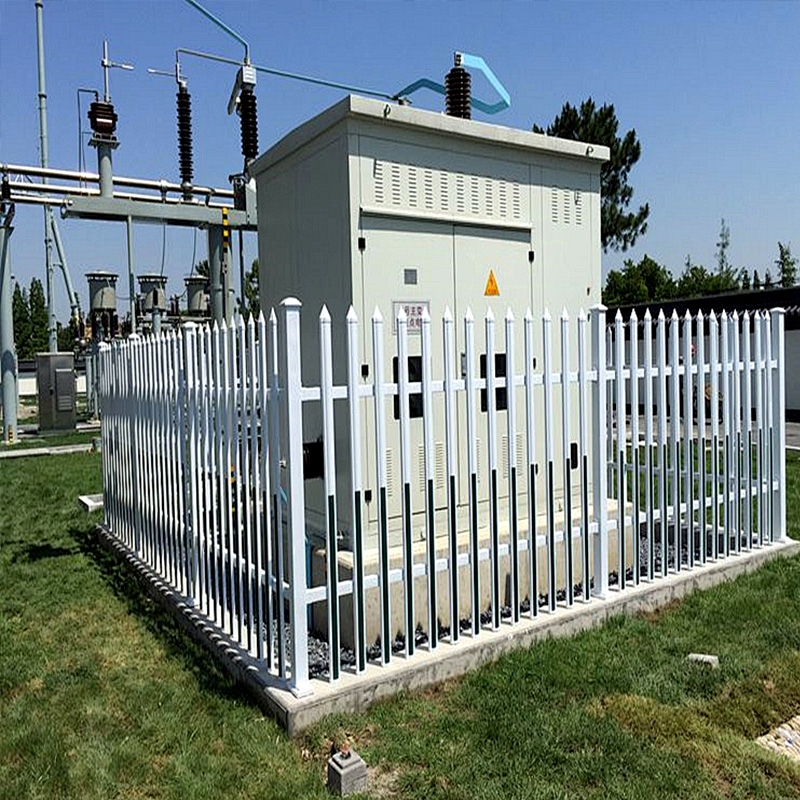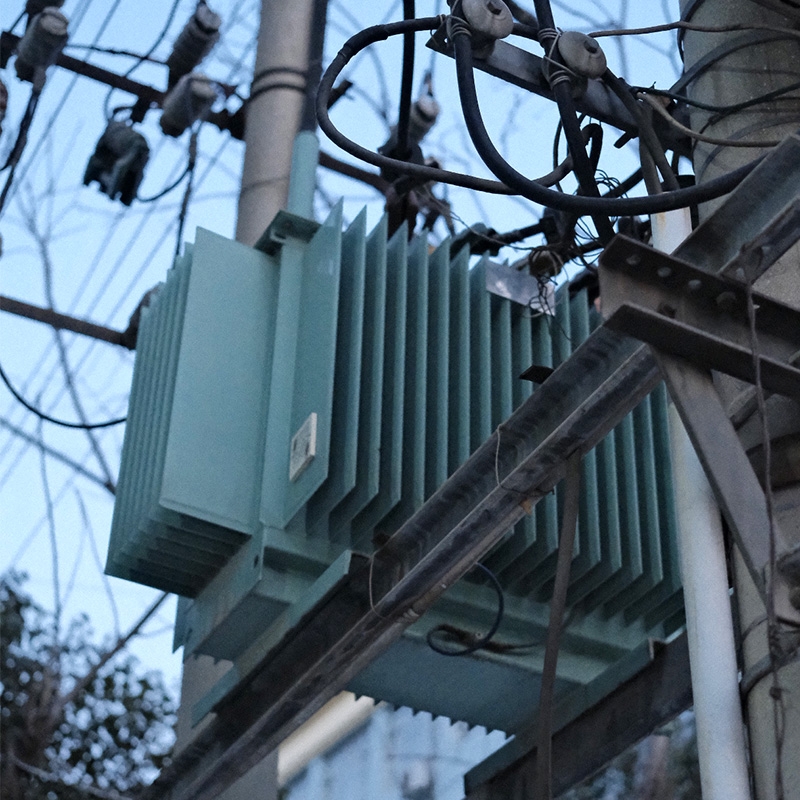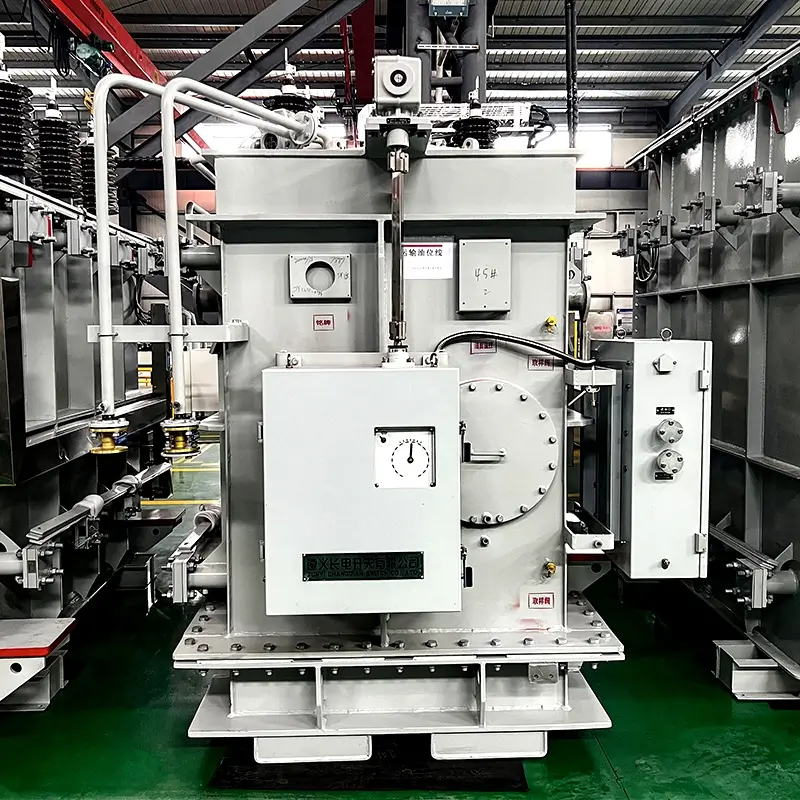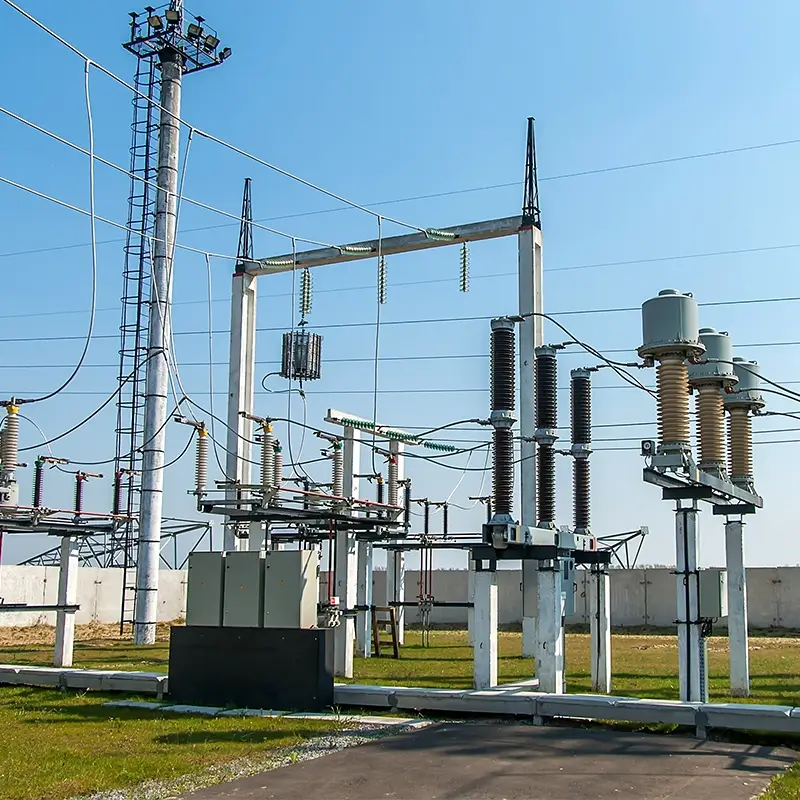Analysis of various abnormalities and fault causes in transformer operation
(I) Abnormal sound During normal operation, due to the alternating current passing through the transformer winding, a periodic alternating magnetic flux is generated in the iron core, causing the magnetic expansion and contraction of the silicon steel sheet, the magnetic force between the joints of the iron core and the lamination, and the electromagnetic force between the conductors of the winding causing vibration. The "buzzing" sound is continuous and uniform, which is a normal phenomenon. If the transformer fails or operates abnormally, the sound will be abnormal. The main reasons are: 1. When the transformer is overloaded, the tone is high and the volume is loud, and a heavy "buzzing" sound will be emitted. 2. When a large dynamic load is started, such as when there is an arc, a thyristor rectifier or other loads, the load changes greatly, and due to the effect of harmonics, the transformer instantly emits a "wow wow" sound or a "cluck" intermittent sound, and the pointer swings when monitoring the measuring instrument. 3. When the power grid is overvoltage, for example, when the neutral point is not grounded, the grid has single-phase grounding or electromagnetic resonance, the transformer sound is sharper than usual. When this happens, a comprehensive judgment can be made in combination with the indication of the voltmeter. 4. When individual parts are loose, the sound is louder than normal and there is obvious noise, but there is no obvious abnormality in the current and voltage. It may be caused by the loosening of the internal clamps or the screws that press the iron core, which increases the vibration of the silicon steel sheet.
5. When the high-voltage bushing of the transformer is dirty, the surface enamel falls off or there are cracks, a "hissing" sound can be heard. If you see blue corona or sparks near the high-voltage bushing of the transformer at night or in rainy weather, it means that the porcelain parts are seriously dirty or the equipment line card has poor contact.
6. When the transformer discharges or has poor contact inside, it will emit a "squeaking" or "crackling" sound, and this sound changes with the distance of the fault location.
7. When some parts of the transformer are in mechanical contact due to the vibration of the iron core, continuous and regular impact or friction sounds will be generated.
8. When there is a boiling sound of water in the transformer, the temperature changes sharply and the oil level rises, it should be judged that the transformer winding has a short circuit fault or the tap changer is seriously overheated due to poor contact. At this time, the transformer should be immediately stopped for inspection. 9. When the transformer core is grounded and disconnected, a crackling sound will be produced. When the transformer windings are short-circuited or they discharge to the outer shell, there will be a crackling sound. In severe cases, there will be a huge roar, which may then catch fire. (II) Abnormal appearance, color, and odor. Internal faults of the transformer and overheating of various components will cause a series of odor and color changes. 1. The rupture of the explosion-proof membrane of the explosion-proof pipe will cause water and moisture to enter the transformer, resulting in emulsification of the insulating oil and reduction of the insulation strength of the transformer. This may be an internal fault or a poor respirator. 2. The discoloration of the respirator silicone may be caused by excessive moisture absorption, damage to the gasket, and too much moisture entering the oil chamber. 3. The loose fastening part of the porcelain bushing connection, the surface contact overheating oxidation, will cause discoloration and abnormal odor. (The color darkens, loses gloss, and the surface coating is damaged.) 4. The contamination of the porcelain bushing produces corona and flashover, which will emit a strange odor. The burning of the cooling fan and oil pump will produce a burning odor. 5. The poor magnetic separation ability of the transformer leakage and the uneven distribution of the magnetic field will cause eddy currents, causing local overheating of the oil tank and causing paint changes or paint peeling. (III) Abnormal oil temperature and oil color Many transformer faults are accompanied by a sharp temperature rise and oil color change. If it is found that under the same normal conditions (load, ambient temperature, cooling), the temperature is more than 10°C higher than usual or the temperature continues to rise under the same load (no abnormality in the meter), it is considered that there is an abnormal phenomenon inside the transformer. The reasons are: 1. The transformer oil temperature will rise due to eddy currents or insulation damage of the bolts clamping the iron core. 2. Short circuits between local layers or turns of the winding, faults in internal contacts, large resistance short circuits on the secondary line, etc., will all cause abnormal transformer temperature. 3. Overload, high ambient temperature, failure of cooling fans and oil pumps, damage to fan motors, fouling of radiator pipes or poor cooling effect, failure of radiator valves to open, insufficient oil caused by oil leakage, etc. will all cause abnormal transformer temperature. 4. When the oil color changes significantly, it should be followed up and tested. If the oil contains carbon particles and water, the acid value of the oil will increase, the lightning will decrease, and the insulation strength of the oil will decrease, which may easily cause the breakdown of the winding and the shell. At this time, it should be stopped and handled in time.
(IV) Abnormal oil level: 1. False oil level: (1) The oil mark tube is blocked; (2) The oil pillow breather is blocked; (3) The air hole of the explosion-proof pipe is blocked.
2. The oil level is too low:
(1) The transformer is seriously leaking oil;
(2) The maintenance personnel did not replenish the oil after draining it many times due to work needs;
(3) The temperature is too low and the oil is insufficient;
(4) The oil pillow capacity is insufficient and cannot meet the operating requirements.
(V) Oil leakage The phenomenon of oil leakage during transformer operation is relatively common. The main reasons are as follows: 1. Poor sealing at the connection between the oil tank and the components, defects in welds or castings, additional loads or vibrations during operation, etc. 2. Internal faults cause the oil temperature to rise, causing the oil volume to expand, resulting in oil leakage or oil spraying.
(VI) Oil pillow or explosion-proof pipe oil spraying
1. When the secondary system suddenly short-circuits and the protection fails to operate, or there is an internal short-circuit fault and the vent and explosion-proof pipe are blocked.
2. The high temperature and heat inside will cause the transformer to suddenly spray oil, and the oil level will drop after the oil spray, which may cause the gas protection to operate.
(VII) Tap changer failure There is a "squeaking" discharge sound on the transformer oil tank, the ammeter swings with the sound, the gas protection may send a signal, and the oil insulation is reduced. These may be phenomena caused by the failure of the tap changer. The reasons for the failure of the tap changer are as follows:
1. The spring pressure of the tap changer contact is insufficient, the pressure of the contact roller is uneven, which reduces the effective contact surface area, and the mechanical strength of the coating is insufficient and the coating is severely worn, which will cause the tap changer to burn out.
2. The tap changer connector has poor contact and cannot withstand the impact of the short-circuit current and fails.
3. When switching the tap changer, the switch burns out due to the wrong tap position switching.
4. The insulation distance between phases is not enough, or the performance of the insulation material is reduced, resulting in a short circuit under the action of overvoltage.
(VIII) Flashover and explosion failure of insulating bushings The bushing is not tightly sealed, and the insulation is damaged due to moisture ingress; the capacitor core of the bushing is poorly manufactured, and the internal free discharge; or the bushing is seriously fouled and cracked, which will cause the bushing flashover and explosion accidents.
(IX) Three-phase voltage imbalance
1. The three-phase load is unbalanced, causing the neutral point to shift, resulting in unbalanced three-phase voltage. 2. Ferromagnetic resonance occurs in the system, resulting in unbalanced three-phase voltage. 3. The winding has a short circuit between turns or layers, resulting in unbalanced three-phase voltage. (X) Relay protection action The relay protection action indicates that the transformer is faulty. Gas protection is one of the main protections of the transformer. It can protect most of the faults that occur inside the transformer. Usually, the light gas action sends a signal first, and then the gas action trips.
Reasons for light gas action: (1) Air enters the transformer due to oil filtering, oil filling, and the cooling system is not tight. (2) Temperature drop and oil leakage cause the oil level to slowly decrease. (3) Internal fault of the transformer, producing a small amount of gas. (4) Internal fault of the transformer short circuit. (5) Fault in the secondary circuit of the protection device. When the external inspection does not find any abnormality in the transformer, the nature of the gas in the gas relay should be found out: if the gas accumulated in the gas relay is non-flammable, colorless and odorless, and the mixed gas is mainly inert gas, the oxygen content is greater than 6%, and the oil ignition point does not decrease, it means that there is a fault inside the transformer, and the nature of the internal fault of the transformer should be identified according to the nature of the gas accumulated in the gas relay; if the color of the gas is yellow and non-flammable, and the carbon monoxide content is greater than 1%-2%, it means that the wood insulation is damaged; if the gray and black gas is flammable and the hydrogen content is less than 3%, there is a tar smell, and the ignition point is reduced, it means that the oil is decomposed due to filtration or a flashover fault has occurred in the oil; light gray with a strong odor and flammable is paper or cardboard insulation damage.
Through the analysis of various abnormalities and fault phenomena in the operation of the transformer, the treatment methods for abnormal operation of the transformer can be understood and mastered.
II. Treatment of abnormal phenomena in transformer operation
(I) Treatment of abnormal phenomena in operation
1. When the on-duty personnel find abnormal phenomena in transformer operation, they should try to eliminate them as soon as possible, report to their superiors and keep records.
2. If the transformer has any of the following conditions, it should be shut down immediately. If there is a spare transformer in use, it should be put into operation as soon as possible:
(1) The transformer noise increases significantly, which is very abnormal, and there is a bursting sound inside;
(2) Serious oil leakage or oil spraying, causing the oil level to drop below the indication limit of the oil level gauge;
(3) The bushing has serious damage and discharge;
(4) The transformer smokes and catches fire.
3. When a fault that endangers the safety of the transformer occurs and the relevant protection device of the transformer refuses to operate, the on-duty personnel should immediately shut down the transformer.
4. When the equipment near the transformer catches fire, explodes or other conditions occur, which pose a serious threat to the transformer, the on-duty personnel should immediately shut down the transformer. 5. When the transformer oil temperature rises above the specified value, the duty personnel shall check and handle it according to the following steps:
(1) Check the transformer load and cooling medium temperature, and compare them with the normal temperature under the same load and cooling medium temperature;
(2) Check the temperature device;
(3) Check the transformer cooling device or the ventilation of the transformer room.
If the temperature rise is due to a cooling system failure and it cannot be repaired during operation, the transformer should be shut down for maintenance; if it cannot be shut down for maintenance immediately, the duty personnel shall adjust the transformer load to the corresponding capacity under the allowable operating temperature according to the provisions of the on-site regulations. Under normal load and cooling conditions, if the transformer temperature is abnormal and continues to rise, and the temperature indication is correct after inspection, it is considered that the transformer has an internal fault and the transformer should be shut down immediately.
When the transformer is operating in various overrated current modes, if the top oil temperature exceeds 105℃, the load should be reduced immediately. 6. When the oil in the transformer is frozen due to low temperature, the transformer should be operated without coolers and the top oil temperature should be monitored. The load should be gradually increased until the corresponding number of coolers are put into operation and the transformer enters normal operation. 7. When the oil level of the transformer is significantly lower than the oil level at the oil temperature, the cause should be found out. When adding oil, the regulations should be followed. It is forbidden to add oil from the bottom of the transformer. 8. When the oil level of the transformer is higher than the oil level indication limit due to the temperature rise, if it is found that it is not caused by false oil level, the oil should be drained to reduce the oil level to the height corresponding to the oil temperature at that time to avoid oil overflow. 9. When the core is grounded at multiple points and the grounding current is large, it should be repaired and handled according to the arrangement. Before the defect is eliminated, measures can be taken to limit the current to about 100mA and strengthen monitoring. 10. When single-phase grounding occurs in the system, the operation of the arc suppression coil and the transformer connected to the arc suppression coil should be monitored. (II) Handling of gas protection device operation When the gas protection signal is activated, the transformer should be checked immediately to find out the cause of the operation, whether it is caused by accumulated air, lowered oil level, secondary circuit fault or internal transformer fault. When the gas protection trips, the transformer shall not be put into operation before the cause is eliminated. To find out the cause, the following factors should be considered and a comprehensive judgment should be made: (1) Whether there is breathing difficulty or incomplete exhaust; (2) Whether the protection and DC secondary circuits are normal; (3) Whether there are any abnormal phenomena on the transformer appearance that clearly reflect the nature of the fault; (4) The amount of gas accumulated in the gas relay and whether it is flammable; (5) The chromatographic analysis results of the gas in the gas relay and the gas dissolved in the oil; (6) The necessary electrical test results; (7) The operation of other relay protection devices of the transformer. (III) Transformer tripping and fire extinguishing 1. After the transformer trips, the cause should be found out immediately. If comprehensive judgment proves that the transformer tripping is not caused by internal fault, it can be put back into operation. If the transformer has signs of internal fault, further inspection should be carried out.
2. After the transformer trips, the oil pump should be stopped immediately.
3. When the transformer catches fire, the power supply should be disconnected immediately, the cooler should be stopped, and fire-fighting measures should be taken quickly to prevent the fire from spreading.
